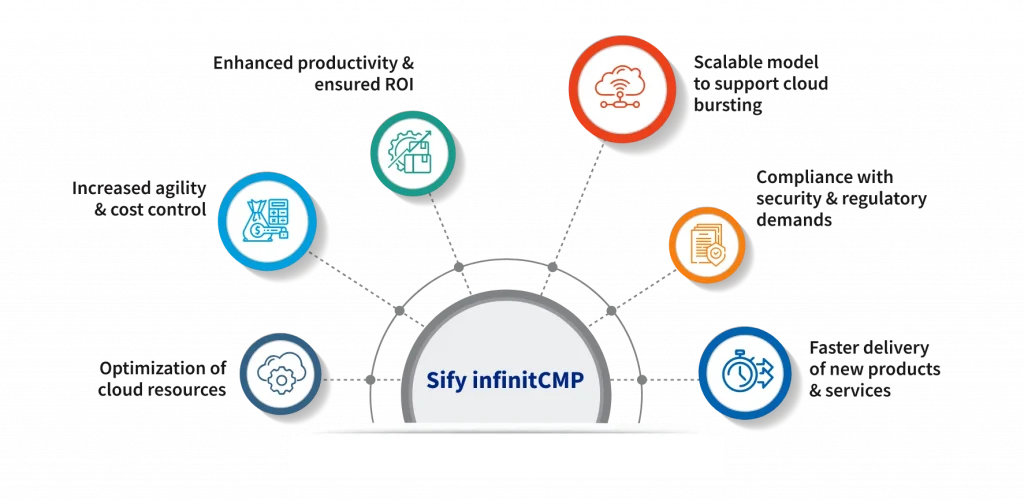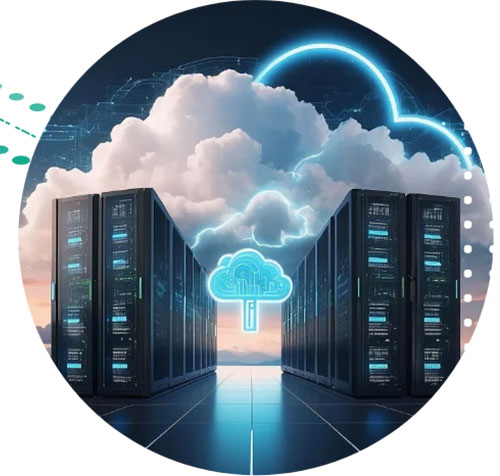When running a business you want the best of everything – the fastest servers, the most secure storage, and the most cost-effective solutions. That’s where multi-cloud comes in. Multi-cloud is widely being adopted by entities who wish to stay agile, competitive, and ahead of the curve.
Multi-cloud is about using cloud services from multiple providers to get the perfect mix of performance, cost efficiency, and scalability. But let’s be honest: juggling multiple clouds can seem overwhelming.
This article breaks it all down for you: what multi-cloud is, the challenges it brings, the solutions to those challenges, and best practices to keep everything running smoothly.
Learn more about Sify’s cloud migration services, here.
What is Multi-Cloud?
Multi-cloud means running cloud computing services from two or more providers simultaneously. Think of it like having a toolbox, where you can handpick a different tool to handle specific tasks.
This approach allows entities to strategically balance workloads as they can reap benefits of the provider’s optimal features. By doing so, your business can Minimize latency, and ensure scalability and compliance.
Multi-cloud doesn’t just refer to the connection of multiple providers but also the creation of a unified environment in which services work seamlessly and homogeneously. It emphasizes flexibility, resilience, and innovation allowing businesses to stay competitive in an ever-changing technological landscape.
Why multi-cloud is gaining popularity
- Avoiding Vendor Lock-In: Multi-cloud solutions let you choose from different providers and ensure that you don’t get tied down to one.
- Flexibility and Scalability: This solution lets you adapt and grow your infrastructure as your business evolves.
- Enhanced Reliability: You can spread your workloads across different platforms to reduce downtime risks with a multi-cloud infrastructure.
Difference Between Multi-Cloud and Hybrid Cloud
There’s a common question – is multi-cloud the same as a hybrid cloud? Not quite. Here are the key differences.
Hybrid Cloud:
Integrates public and private clouds, often connecting on-premises infrastructure to cloud environments.
This is primarily suitable for companies with sensitive information or critical workloads that require additional security or compliance. For instance, a hybrid cloud framework can hold confidential operations in a secure private environment while it handles sensitive workloads or handles overflow of traffic in a public environment.
The hybrid model ensures interoperability between environments, so businesses can easily switch between them as needed. This makes it especially valuable for scenarios like disaster recovery, scaling during peak demands, or testing new applications without disrupting core systems.
Multi-Cloud
Multi-cloud refers to the strategic use of multiple cloud environments, often tailored for specific workloads, applications, or business objectives. It enables organizations to diversify their cloud infrastructure by spreading workloads across various environments, depending on their unique strengths.
The key strength of multi-cloud is flexibility and adaptability. A business can assign resources more effectively to fulfill varying demands, make the system more reliable by decreasing dependency on a single platform, and avoid bottlenecks by optimizing workloads.
Think of hybrid cloud as owning a car and occasionally renting another for specific trips. Multi-cloud on the other hand is like using a car, bike, or train depending on where you’re going and what’s most efficient.
Simply put, hybrid cloud is used to balance control and scalability, whereas multi-cloud highlights flexibility and diversification. Several organizations use these strategies together in building a complete cloud framework.
Read more about hybrid/multi-cloud adoption and management here.
Benefits of Multi-Cloud
Adopting a multi-cloud strategy will give your business access to a multitude of benefits, changing the way it operates. Here are some of the advantages:
- Flexibility and Agility
With multi-cloud, businesses can pick the best tools and services for each specific workload. This allows organizations to be agile and responsive to market changes and deploy new solutions without being limited by the constraints of a single provider. - Avoiding Vendor Lock-In
Businesses are exposed to various risks such as price changes, service disruptions, or technological limitations when relying on a single provider. The use of multi-cloud diversifies resources across different providers, thereby giving businesses independence and more control. - Improved reliability and redundancy
Distributing workloads on multiple platforms gives businesses a significant reduction in potential downtime due to outages. If one of the providers hits an issue, services can reroute to the other, giving continuous operations, and improving disaster recovery capabilities. - Cost optimisation
In multi-cloud strategies, businesses can make selections based on specific cost-performance metrics. With this, it is possible for them to obtain competitive pricing for services and prevent overpaying for services they may not need. - Access to Advanced Technologies
Cloud providers are constantly innovating, providing the latest tools, including artificial intelligence, machine learning, and advanced analytics. Multi-cloud environments allow businesses to incorporate these technologies into their operations without being bound by the limitations of a single vendor’s offerings. - Compliance and Regional Adaptability
Every sector and area has its own set of regulations that businesses must comply with. A multi-cloud approach allows enterprise organizations to meet compliance requirements by using providers that operate in specific regions or adhere to certain standards.
Understand how automation across multi-cloud solutions can enhance your cloud ecosystem, here.
Challenges in Multi-Cloud Adoption
Multi-cloud may seem like the holy grail of solutions, but it is not without its own set of challenges. Enlisted are some of the key challenges:
- Complexity in Management
Multiple clouds with various interfaces, tools, and policies can seem overwhelming even to the most experienced IT teams. - Security and Compliance Risks
It is difficult to keep data safe across various platforms while following compliance standards. - Integration Issues
To ensure seamless connection of different cloud environments, advanced tools and expertise are required. - Performance Inconsistencies
Not all clouds are created equal. Some may outperform others, leading to bottlenecks. - Cost Management
Tracking and optimizing costs across multiple providers can quickly become a headache without proper governance.
Solutions to Multi-Cloud Challenges
Here are some ways you can overcome the challenges of multi-cloud:
- Use a Multi-Cloud Management Platform
Sify’s CloudInfinit Gen-5 Platform, for example, makes operations easier by providing a single dashboard to monitor and manage multiple clouds. - Standardize Security Practices
Consistent and stringent security policies can help protect your data. - Adopt Open Standards
Technologies like Kubernetes make it easier to move workloads between clouds. - Automate Repetitive Tasks
Leverage automation for deploying updates, monitoring workloads, and handling routine processes. - Reduce Costs with Governance Tools
Use tools to track and manage spending across clouds.
Best Practices for Multi-Cloud Integration
Here are some multi-cloud best practices to keep in mind:
- Define a Clear Strategy
- Establish Goals: Know why you’re adopting multi-cloud and what you want to achieve.
- Map Workload: Assure the fitting workload for each of the cloud environments.
- Focus on Interoperability
Set up tools and frameworks that guarantee seamless interaction between your cloud platforms. - Monitor Performance and Security
Use tools for unified monitoring to track your systems and address issues proactively. - Pilot small before scaling large
Test the multi-cloud strategy on smaller workloads before using it for mission-critical applications.
Why Sify Multi-cloud Services Stand Out
Sify InfinitCMP simplifies multi-cloud integration. Here are some of the key solutions Sify offers:
- Centralized Management: Single, unified dashboard to manage several cloud environments.
- Cost Optimization: Trackable insights to help you avoid unnecessary spending.
- Enhanced Security: Standardized policies that ensure consistent data security across platforms.
- Expert Support: Access to 24/7 assistance from certified cloud professionals.
With Sify, you can simplify your multi-cloud journey while focusing on growing your business.

The Future of Multi-Cloud
With entities embracing a digital-first approach, multi-cloud will be the new norm. Further developments in emerging technologies such as AI and ML will enhance multi-cloud solutions, enabling smarter workload distribution and cost optimization. Here’s what the future of multi-cloud looks like:
- AI-led Multi-Cloud Management
Artificial intelligence (AI) and machine learning (ML) will change the way businesses operate multi-cloud environments. Predictive analytics and automated decision-making will optimize workload distribution, reduce costs, and enhance performance. - Greater Interoperability
Multi-cloud providers are increasingly working toward open standards and enhanced interoperability. This will make it easier to integrate and migrate workloads across different platforms, reducing vendor lock-in and increasing flexibility. - Edge Computing Integration
The rise of edge computing will supplement multi-cloud strategies by bringing processing power closer to the data source. This will be particularly beneficial for latency-sensitive applications like IoT and real-time analytics. - Stronger Security Frameworks
As multi-cloud adoption increases, so will the emphasis on advanced security measures. Unified security frameworks and cross-cloud compliance solutions will become the norm, ensuring data protection across all platforms. As businesses continue to adopt digital-first strategies, multi-cloud will become the standard. Emerging technologies like AI and machine learning will further enhance multi-cloud capabilities, enabling smarter workload distribution and cost optimization.
Multi-cloud provides flexibility, scalability, and resilience. However, to fully benefit from it, you need a clear strategy, the right tools, and a reliable partner like Sify. Addressing the challenges head-on and following best practices will ensure that your business thrives in the multi-cloud era.
To know more about Sify’s secure multi-cloud solutions, speak to our team of experts today.































































